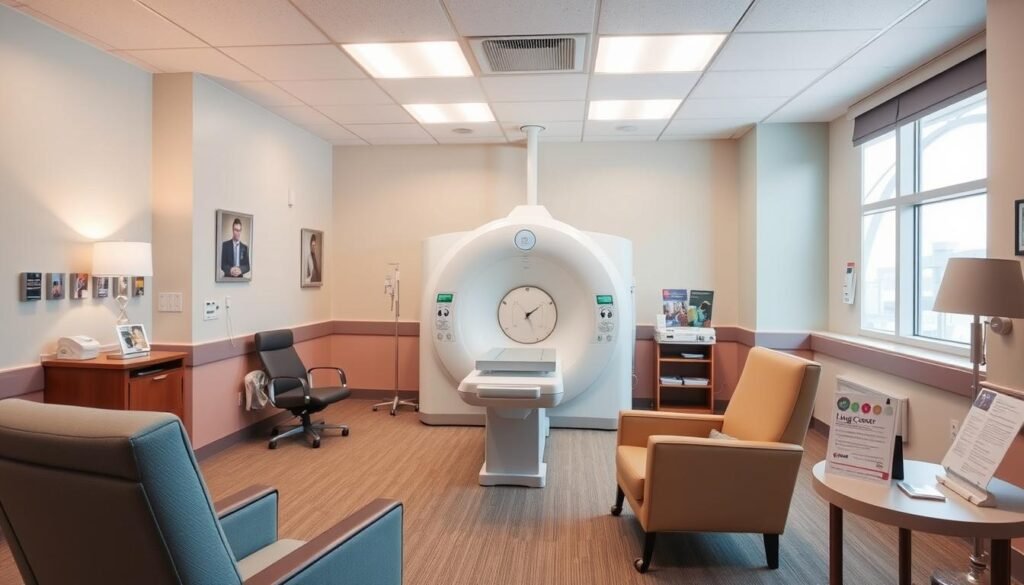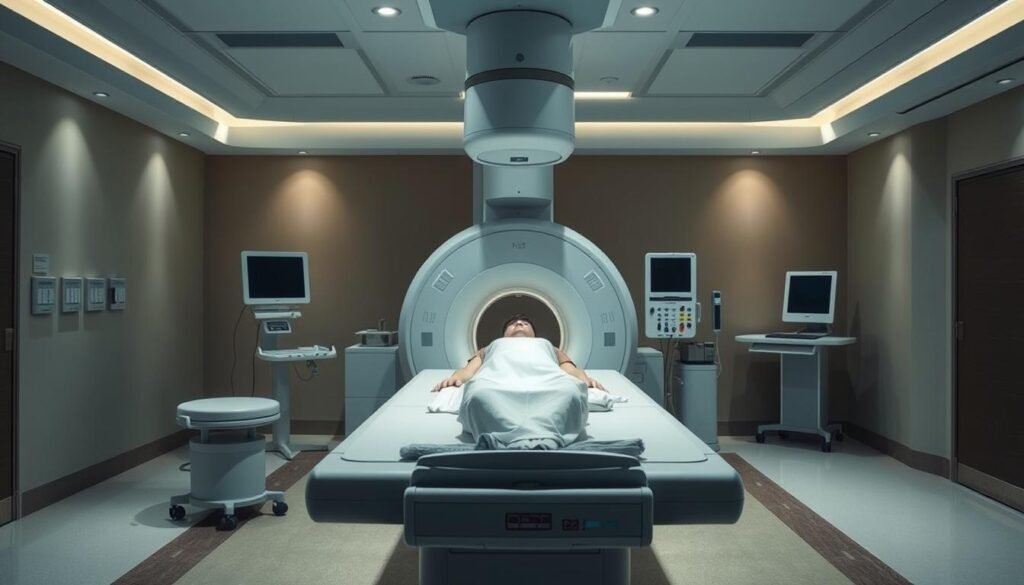Nearly 72% of lung cancer patients find keeping a balanced diet helps with side effects of radiation therapy. It’s important to be prepared when starting one of the treatments for lung cancer. Knowing about your first radiation treatment can make things less scary.
Radiation oncology has improved a lot. Learning what your treatment involves can help make the experience better. By finding out what to expect and how to prepare, you can start your treatment feeling ready and calm.
Key Takeaways
- Nearly 72% of patients find that a balanced diet helps in managing side effects during radiation therapy.
- It is essential to eat protein-rich foods at every meal to maintain energy levels.
- Emotional support from friends, family, or support groups can help alleviate feelings of fear and anxiety during treatment.
- Exercise can significantly improve emotional well-being and reduce fatigue; starting slow is advised.
- Consultation with healthcare professionals is crucial for creating a personalized treatment plan.
- Understanding the simulation process is key for a successful and effective radiation treatment plan.
- Follow-up appointments post-treatment play a vital role in monitoring recovery and effectiveness.
Understanding Lung Cancer Radiation Therapy
Lung cancer radiation therapy is key in treating this disease. It uses high-energy rays to attack cancer cells, aiding in recovery. This method is often part of a bigger treatment plan. It can be combined with surgery or chemotherapy.
What is Radiation Therapy?
Radiation therapy uses high-energy rays, like X-rays, to kill or stop cancer cells. Over half of cancer patients receive radiation. The treatment is customized based on the cancer type, stage, and overall health. It can shrink tumors before surgery or destroy cells left after.
Types of Radiation Used for Lung Cancer
There are main types of radiation for lung cancer:
- External Beam Radiation Therapy (EBRT) — This aims high-energy beams at the tumor from outside. It’s usually given five days a week for several weeks. Some treatments are shorter, though, lasting one to two weeks.
- Brachytherapy — This involves putting radioactive material near or in the tumor. It’s good for shrinking tumors in the airway.
New methods like Stereotactic Body Radiation Therapy (SBRT) and Intensity Modulated Radiation Therapy (IMRT) offer precise treatment. They protect healthy tissues better. Proton therapy is also effective, especially for Stage III cancer. It reduces the risk to other organs.
Learning about radiation therapy helps patients take an active role in their treatment. For more on lung cancer radiation therapy, side effects, and planning, visit this resource.
Preparing for Your First Radiation Treatment for Lung Cancer
Getting ready for lung cancer treatment can be hard. Preparing for radiotherapy is key to feeling less worried. It’s important to plan the first steps, like setting up a simulation visit. This helps make the whole process easier. Paying attention and talking clearly with your doctors is also crucial.
Initial Preparations and Planning
Before starting radiation, there are important steps to take. Learn where the treatment center is and what parking is like. Know what you need to bring each time. Following the right diet and doing any needed tests beforehand helps a lot. It’s also key to talk about any fears or questions with your health team.
Scheduling Your Simulation Appointment
Making a simulation appointment is a big part of getting ready for radiotherapy. This meeting helps plan your treatment area and customizes your plan. It’s best to set this up early and keep talking to your healthcare team. They can help you know what to expect. You can find more help by visiting additional resources. Proper planning makes starting radiation therapy smoother.

What to Expect on Your First Day of Treatment
When you go for your first day of radiation treatment, expect everything to be well planned. You will need to know the treatment center procedures. This will help you feel ready. Also, knowing where to park and the treatment center’s address is key.
Arriving at the Treatment Center
It’s good to arrive a bit early for your appointment. This way, you can deal with any last-minute issues. Always check the treatment center’s instructions on where to enter and check in.
Check-in Process and What to Bring
At check-in, you’ll confirm your personal info and your appointment. Some places have a self-check-in, making it quicker. Knowing what to bring for radiation treatment is important:
- Wear comfy clothes since you might need to change.
- Bring things that relax you, like headphones or a book.
- Have a list of questions for your care team to make sure you understand your treatment well.
Being prepared can help lessen your worries. It makes your first day smoother. Also, knowing about lung cancer’s early signs is useful. This knowledge shows why your treatment is vital. For more info on early signs, click here.
Understanding the Simulation Process
The simulation process is key before radiation therapy begins. Its aim is to target the affected area accurately. This increases safety and comfort for the patient. Healthcare pros use advanced imaging to map out the treatment zone. This step is crucial for the success of the radiation therapy.
Purpose and Importance of Simulation
Radiation simulation is all about making a treatment plan that fits the patient. It helps doctors see where they need to treat. This ensures they hit the cancer cells but not the healthy tissue. A consistent setup for treatment sessions makes the radiation both safe and effective.
Imaging Techniques Used
Several imaging methods are crucial in the simulation stage. These include:
- CT scans – They show detailed images of the body’s cross-section. They sometimes use a contrast dye for clearer pictures.
- MRI – This gives excellent images of soft tissues, which is especially useful for certain cancers.
- PET scans – These scans reveal the cancer’s metabolic activity.
Usually, the simulation takes about an hour. After that, a team works with the oncologist to craft a perfect treatment plan. This team effort, which includes quality checks, can take a week or longer. It ensures the plan fits what the equipment can do.
During radiation therapy, there’s weekly imaging to check everything is still accurate. If not, they make necessary adjustments. This careful preparation improves the treatment’s success. It also leads to better results for patients.

Creating a Radiation Treatment Plan
Creating a tailor-made radiation plan is key in fighting lung cancer. It must match the patient’s unique needs and health situation. Doctors look at many things like tumor size and where it is to make a plan just right for the patient.
How Treatment Plans are Developed
The making of a radiation treatment plan takes several steps. First, doctors look at your medical history and tests. Then, they think about using methods like 3D-CRT or IMRT. These methods are picked for how well they can target the tumor’s shape. This custom approach helps make the treatment work better.
Importance of Personalization in Treatment
Having a treatment plan made just for you is very important. It helps reduce bad effects and makes the treatment work best. Patients sharing their thoughts on their treatment make it better. This teamwork makes the treatment more accurate.
This kind of plan aims to get the right amount of radiation to cancer cells but not hurt healthy tissue. It’s all about making sure you stay as well as possible while fighting cancer.
Managing Your Health Before Treatment
Before starting radiation therapy, taking the right steps can hugely affect your health and well-being. It’s important to focus on your diet, drink enough water, and get plenty of rest. Doing this prepares your body for what’s ahead. These steps can help you manage side effects and recover more quickly.
Diet and Nutrition Tips
Eating right before radiation is key to keeping your energy up and staying healthy. A diet with enough calories and protein helps your body cope during treatment. It can also ease some side effects. Here are things to do:
- Consuming high-protein foods, such as lean meats, fish, eggs, and legumes.
- Incorporating a variety of fruits and vegetables to ensure a wide range of nutrients.
- Choosing whole grains for sustained energy release.
- Eating smaller, more frequent meals if appetite decreases.
These changes make sure your body is ready to face the demands of radiation therapy.
Importance of Hydration and Rest
It’s very important for all patients to drink enough water. Here are some hydration tips:
- Drinking plenty of water throughout the day.
- Avoiding too much caffeine and alcohol, which can dehydrate you.
- Consuming hydrating foods like fruits and soups.
Drinking enough water helps with side effects and keeps your body working well. Rest is just as key. Radiation can make you more tired than usual. Taking short naps and relaxing can make your sleep better.

Together, these steps make your body stronger and more ready for radiation therapy. Starting with good nutrition and rest helps you face treatment with more confidence.
Common Side Effects of Radiation Therapy
Patients getting radiation therapy may face different side effects during treatment. It’s key to know about these to better handle discomfort and aid recovery. Side effects are either short-term or long-term, and managing them well is important for patients.
Short-term Side Effects
Short-term side effects usually start in the second or third week of treatment. They can last for weeks after the last session. Common ones are:
- Fatigue
- Skin reactions such as dryness, redness, and peeling
- Changes in appetite
- Mouth and throat changes, including sores and dry mouth
- Swelling and coughing
- Nausea and vomiting
- Diarrhea
These side effects often get better 1 to 2 months after treatment ends. Staying active daily can help reduce fatigue and improve recovery.
Long-term Side Effects and Management
Some side effects may last longer or appear later. For example, radiation can alter blood cell counts, causing future health issues. The treatment area affects the type of long-term side effects, such as:
| Treatment Area | Potential Long-term Side Effects |
|---|---|
| Chest | Breathing and swallowing difficulties |
| Head and Neck | Persistent dry mouth, difficulty swallowing, dental issues |
| Abdominal | Nausea, diarrhea, constipation |
| Pelvic | Urinary incontinence, sexual health changes |
Dealing with these long-term effects requires open communication with your health team. By speaking up about side effects, you can get specific help. This might include meds, diet changes, and emotional support. For more info, check out this resource.
Coping Strategies During Radiation Treatment
During radiation therapy for lung cancer, it’s crucial to manage your emotional well-being. Patients often feel anxiety and sadness. It helps to seek emotional support during this time. Professional advisors, counselors, and support groups offer comfort. They make individuals feel less alone in their journey.
Emotional and Psychological Support
Talking with others who are facing the same challenges can be comforting. Being part of a support group gives a sense of community. Palliative care specialists also provide emotional support and aim to improve life quality. They help connect patients with mental health professionals, building a strong support network.
Tips for Relaxation and Stress Relief
Besides getting emotional support, using relaxation strategies is key. Mindfulness meditation, music therapy, and gentle yoga can greatly improve relaxation. These activities help clear the mind and soothe the spirit. They make treatment periods more positive. Trying deep breathing and journaling also helps. These simple acts let patients express their feelings and find some control during tough times.